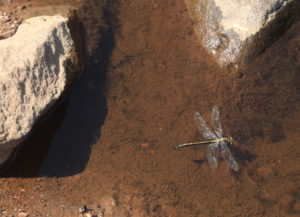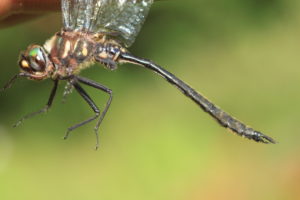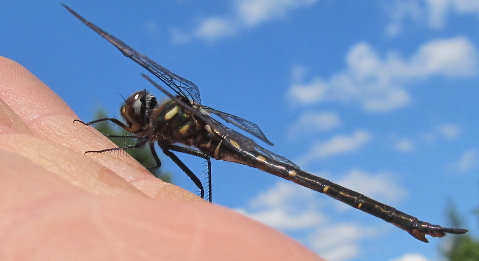I wandered up to the sandy outwash moraines north of my home a few days ago, to see what’s happening on small to medium streams. Last week Hagenius brevistylus (dragonhunter) was star of the show. I glimpsed a brief aerial melee where 4-5 hags were aggressively engaged with each other over the stream before scattering. I only caught the tail end of the brouhaha, so I’m not sure exactly what transpired. Perhaps it was several amorous males competing for the attention of a female, or just a brief border war between territories.
I looked down and found additional evidence suggestive of violent aerial disputes. Floating near shore was a dead male Hagenius (there’s only one species in the genus). I can’t be sure what happened but I do know males are very aggressive; it may have been knocked out of the sky by another male.
 Hags were in evidence on other small streams too. I found them patroliing up and down streams, their large size and characteristic J-shaped abdomens giving them away. I found them perched on culverts overlooking pools and riffles, and perched in their typical awkward-looking fashion on tiny twigs overlooking the water.
Hags were in evidence on other small streams too. I found them patroliing up and down streams, their large size and characteristic J-shaped abdomens giving them away. I found them perched on culverts overlooking pools and riffles, and perched in their typical awkward-looking fashion on tiny twigs overlooking the water.
But that was last week; this week they are scarce. Things are in flux now, transitioning from early summer species to late summer species. They are clearly on the wane now so I decide to head up the railroad track and visit a stream I’ve never sampled before. The lure of the unknown is always irresistible.
As soon as I arrive at the stream, I spot something resting on a rock below the trestle. I enlarge a blurry camera image that I shot from the bridge above and can make out a dark clubtail with abdominal rings and a very large club. Its Stylurus scudderi, or zebra clubtail, a fairly uncommon find. This one is particularly wary though. I scramble down the slope and spend an hour trying to net it but it never lets me get close. The footing is rocky and awkward, and my stumbling, lurching approach scares it off each time.
I finally concede defeat and move downstream, wading into the soft mushy shore near a small bed of cattails. I quickly spot something else that piques my interest even more: a Somatochlora flying along the shoreline then circling back downstream along a brushpile in the middle of the stream.It repeats this several times as I try to decide what it might be. It looks too large for Somatochlora minor, and it looks too small to be the S. williamsonia I was hoping for. I creep further downstream into softer and weaker layers of cattail detritus, until I risk breaking through. I position my net hoop in the vegetation at stream’s edge, the camouflaged opening pointed downstream, and wait.
I don’t have to wait long until it returns to its beat. It flies upstream, low along the shore, and with a quick flip of my wrists its in the net. It turns out to be something even better than I expected. Its S. elongata, the ski-tailed emerald! I’ve spent most of my years surveying dragonflies in bogs or collecting larvae in streams, and much lot less time surveying adults of small streams. This is one of a very few times I’ve encountered elongata adults. Its a more than ample reward for my efforts chasing the uncooperative Stylurus scudderi.

Somatochlora elongata, the ski-tailed emerald
